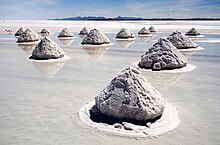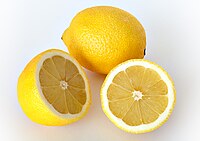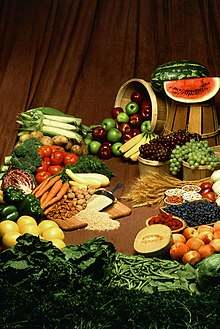Many plants or plant parts are eaten as food. There are around 2,000 plant species which are cultivated for food, and many have several distinct cultivars.[4]
Seeds of plants are a good source of food for animals, including humans because they contain nutrients necessary for the plant's initial growth, including many healthy fats, such as Omega fats. In fact, the majority of food consumed by human beings are seed-based foods. Edible seeds include cereals (such as maize, wheat, and rice), legumes (such as beans, peas, and lentils), and nuts. Oilseeds are often pressed to produce rich oils, such as sunflower, flaxseed, rapeseed (including canola oil), and sesame.[5]
One of the earliest food recipes made from ground chickpeas is called hummus, which can be traced back to Ancient Egypt times. Seeds are typically high in unsaturated fats and, in moderation, are considered a health food, although not all seeds are edible. Large seeds, such as those from a lemon pose a choking hazard, whereas seeds from apples and cherries contain poison cyanide.
Fruits are the ripened ovaries of plants, including the seeds within. Many plants have evolved fruits that are attractive as a food source to animals, so that animals will eat the fruits and excrete the seeds some distance away. Fruits, therefore, make up a significant part of the diets of most cultures. Some botanical fruits, such as tomatoes, pumpkins and eggplants, are eaten as vegetables.[6] (For more information, see list of fruits.)
Vegetables are a second type of plant matter that is commonly eaten as food. These include root vegetables (such as potatoes and carrots), leaf vegetables (such as spinach and lettuce), stem vegetables (such as bamboo shoots and asparagus), and inflorescence vegetables (such as globe artichokes and broccoli). Many herbs and spices are highly flavorsome vegetables.[7]
Sweet
Generally regarded as the most pleasant taste, sweetness is almost always caused by a type of simple sugar such as glucose and fructose, or disaccharides such as sucrose, a molecule of both combined.[14] Complex carbohydrates are long chains and thus do not have the sweet taste. Artificial sweeteners such as sucralose are used to mimic the sugar molecule, creating the sensation of sweet, without the calories. Other types of sugar include raw sugar which is known for its amber color, as it is unprocessed. As sugar is vital for energy and survival, the taste of sugar is pleasant.The stevia plant contains a compound known as steviol which extracted, has 300 times the sweetness of sugar while having minimal impact on blood sugar.[15]
Sour
Sourness is caused by the taste of acids, such as vinegar or ethanol in alcoholic beverages. Sour foods include citrus, specifically lemons, limes and to a lesser degree, oranges. Sour is evolutionarily significant as it is a sign for a food that may have gone rancid due to bacteria.[16] Many foods, however, are slightly acidic as they help stimulate the taste buds and enhance flavor.Salty

Salt mounds in Bolivia.
Bitter

The rind of a lemon is exceptionally bitter, while the lemon itself is characterized as sour.
Umami
Umami, the Japanese word for delicious, is the least known in popular culture in Western culture but has a long tradition in Asian cuisine. Umami is the taste of glutamates, especially monosodium glutamate or MSG.[14] It is characterized as savory, meaty and rich in flavor. Salmon and mushrooms are foods high in umami. Meat and other animal byproducts are described as having this taste.Presentation
Main article: Food presentation
It is known that when presented with food, the consumer "eats" first with their eyes, a universal psychological phenomenon. Food presented in a clean and appetizing way will encourage a good flavor, even if unsatisfactory.[18][19].

